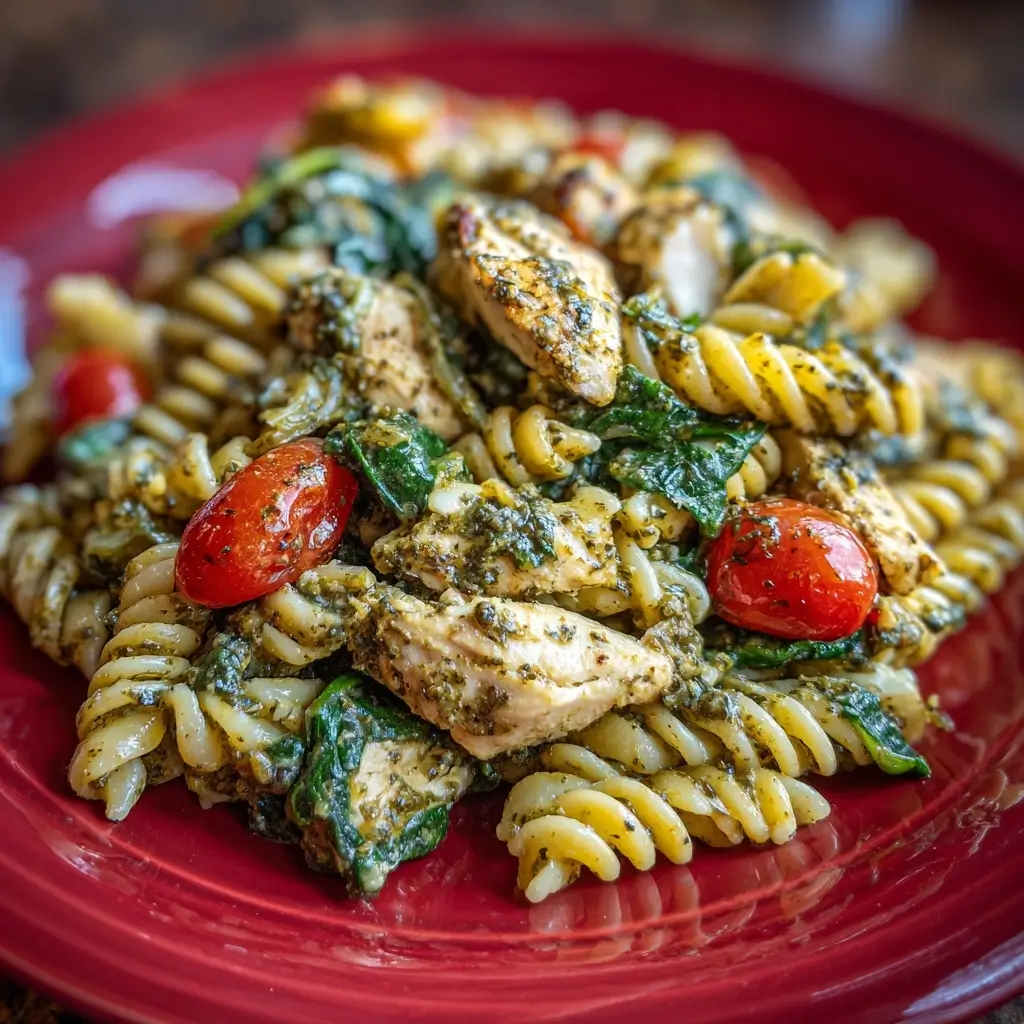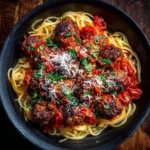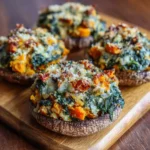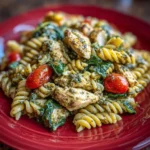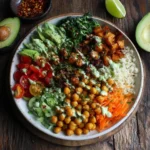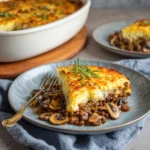Chicken Pesto Pasta with Spinach: A Flavorful, Nutritious Delight
If you’re looking for a satisfying, wholesome meal that combines rich flavors and vibrant colors, Chicken Pesto Pasta with Spinach is the perfect choice. This dish brings together tender chicken breast, al dente pasta, fresh baby spinach, and a luscious homemade or store-bought pesto sauce to create a restaurant-quality meal in the comfort of your kitchen. Whether you’re preparing a weeknight dinner or entertaining guests, this recipe offers both elegance and ease. It’s balanced, nutritious, and customizable to suit various dietary preferences, making it a staple favorite across homes and restaurants alike.
The History of Chicken Pesto Pasta with Spinach
The roots of Chicken Pesto Pasta with Spinach can be traced back to the culinary traditions of Italy, particularly Liguria, where pesto originated. Traditional pesto alla genovese is made from fresh basil, garlic, pine nuts, Parmesan cheese, and olive oil—pounded together using a mortar and pestle. Over time, Italian-American cuisine began adapting this classic sauce, incorporating proteins like grilled chicken and vegetables such as spinach to make heartier, more substantial dishes.
Pasta itself has been a cornerstone of Italian cooking since the Middle Ages, but the fusion of pasta with proteins and sauces evolved significantly during the 19th and 20th centuries, especially as Italian immigrants brought their recipes to the United States. The addition of chicken to pasta dishes became popular in American households due to its affordability, versatility, and mild flavor that pairs well with bold sauces like pesto. Spinach, known for its nutritional benefits and vibrant green hue, was a natural addition, enhancing both the color and health profile of the dish.
Today, Chicken Pesto Pasta with Spinach is celebrated worldwide—not only for its delicious taste but also for its ability to bridge traditional Italian flavors with modern, health-conscious eating habits. It reflects a global appreciation for meals that are not only tasty but also nourishing and visually appealing.
Ingredients Breakdown: What Makes This Dish Shine
The magic of Chicken Pesto Pasta with Spinach lies in the harmony of its ingredients. Each component plays a vital role in creating layers of flavor, texture, and nutrition:
- Pasta: Traditionally, linguine or fettuccine is used, but penne, farfalle, or even whole wheat pasta work beautifully. The pasta provides a sturdy base that holds the creamy pesto and complements the tender chicken and wilted spinach.
- Chicken Breast: Lean and protein-rich, boneless, skinless chicken breasts are ideal. They absorb the flavors of herbs and seasonings while remaining juicy when cooked properly.
- Fresh Spinach: Baby spinach is preferred for its delicate texture and mild flavor. It wilts quickly into the hot pasta, adding color, fiber, and essential nutrients without overpowering the dish.
- Pesto Sauce: Whether homemade or store-bought, pesto is the star. Authentic pesto contains basil, garlic, pine nuts, olive oil, and Parmigiano-Reggiano. Some variations include arugula, walnuts, or sun-dried tomatoes for a twist.
- Olive Oil: Used for sautéing chicken and spinach, high-quality extra virgin olive oil enhances the richness and aroma of the entire dish.
- Garlic: Freshly minced garlic adds depth and a slight pungency that balances the herbal notes of the pesto.
- Salt and Black Pepper: Essential seasonings that elevate all the components.
- Lemon Juice (optional): A splash brightens the dish and cuts through the richness of the pesto.
- Grated Parmesan Cheese: Adds a salty, umami kick and creamy mouthfeel when stirred into the warm pasta.
- Cherry Tomatoes or Sun-Dried Tomatoes (optional): For added sweetness, acidity, and visual appeal.
- Pine Nuts or Walnuts (optional topping): Toasted nuts add crunch and enhance the nutty flavor already present in the pesto.
Together, these ingredients form a symphony of taste and texture—creamy, savory, herbal, slightly tangy, and deeply satisfying.
Step-by-Step Recipe: How to Make Chicken Pesto Pasta with Spinach
Follow this detailed guide to prepare a flawless Chicken Pesto Pasta with Spinach that will impress your family and friends.
- Cook the Pasta:
Bring a large pot of salted water to a boil. Add 12 ounces (about 340g) of your preferred pasta—linguine, penne, or fusilli work well. Cook according to package instructions until al dente (usually 9–12 minutes). Reserve ½ cup of pasta water before draining. Set aside. - Prepare the Chicken:
While the pasta cooks, season 2 boneless, skinless chicken breasts (about 1 lb / 450g total) with salt, black pepper, and a pinch of garlic powder. Heat 1 tablespoon of olive oil in a large skillet over medium-high heat. Add the chicken and cook for 5–6 minutes per side, or until golden brown and internal temperature reaches 165°F (74°C). Remove from the pan, let rest for 5 minutes, then slice into thin strips or bite-sized cubes. - Sauté the Aromatics:
In the same skillet, reduce heat to medium. Add another tablespoon of olive oil, followed by 2 cloves of minced garlic. Sauté for about 30 seconds until fragrant—be careful not to burn. - Add the Spinach:
Add 4–5 cups of fresh baby spinach (packed) to the skillet. Toss gently and cook for 1–2 minutes until just wilted. If desired, splash in a teaspoon of lemon juice to brighten the greens. - Combine Everything:
Return the sliced chicken to the skillet. Add the drained pasta and ⅓ to ½ cup of prepared pesto (homemade or store-bought). Toss everything together over low heat. Use reserved pasta water, a few tablespoons at a time, to loosen the sauce and help it coat the noodles evenly. - Finish and Serve:
Remove from heat. Stir in ¼ to ½ cup of grated Parmesan cheese. Taste and adjust seasoning with additional salt, pepper, or lemon juice if needed. Garnish with extra Parmesan, toasted pine nuts, and a drizzle of olive oil if desired.
Serve immediately while hot. This dish pairs wonderfully with a crisp green salad, garlic bread, or roasted vegetables.
Tips for Perfect Chicken Pesto Pasta Every Time
- Don’t Overcook the Pasta: Always aim for al dente. Overcooked pasta becomes mushy, especially once mixed with sauce and residual heat.
- Reserve Pasta Water: The starchy liquid helps bind the pesto to the pasta, creating a silky, cohesive sauce without needing excess oil or cream.
- Cook Chicken Evenly: Pound thicker chicken breasts to an even thickness (about ¾ inch) to ensure uniform cooking and prevent dryness.
- Rest the Chicken: Letting the chicken rest after cooking allows juices to redistribute, keeping it moist and flavorful.
- Use High-Quality Pesto: If using store-bought, choose one with simple ingredients—basil, olive oil, garlic, cheese, nuts. Avoid preservatives and artificial flavors. Or better yet, make your own!
- Wilt Spinach Gently: Don’t overcook the spinach; it should retain some texture and vibrancy.
- Add Lemon Zest: For an extra burst of freshness, stir in a teaspoon of lemon zest at the end.
- Reheat with Care: When reheating leftovers, add a splash of water or broth and warm on low to prevent the pesto from separating or drying out.
- Time Management: Start cooking the chicken first, then begin the pasta as the chicken rests. This ensures everything finishes around the same time.
- Season in Layers: Season each component (chicken, pasta water, final dish) rather than relying on one big seasoning at the end.
Variations and Customizations: Make It Your Own
One of the best things about Chicken Pesto Pasta with Spinach is how easily it can be adapted. Here are some creative twists:
- Vegetarian Version: Skip the chicken and add white beans, chickpeas, or marinated tofu for plant-based protein.
- Vegan Option: Use dairy-free pesto (without cheese or with nutritional yeast), omit Parmesan, and use vegan protein sources like tempeh or lentils.
- Gluten-Free: Substitute regular pasta with gluten-free pasta made from rice, corn, or quinoa. Ensure all other ingredients are certified gluten-free.
- Add More Veggies: Incorporate roasted bell peppers, zucchini, mushrooms, artichoke hearts, or cherry tomatoes for added color, texture, and nutrition.
- Seafood Twist: Replace chicken with grilled shrimp or seared salmon for a luxurious variation.
- Different Greens: Swap spinach with arugula, kale (massaged first), or Swiss chard for varied flavor profiles.
- Nut Variations: Use walnuts, almonds, or cashews instead of pine nuts in homemade pesto—each imparts a unique taste and cost efficiency.
- Herb Swaps: Try a mix of basil and mint, or all arugula pesto for a peppery kick.
- Creamy Upgrade: Stir in a spoonful of mascarpone, ricotta, or heavy cream for a richer, silkier sauce.
- Spicy Kick: Add red pepper flakes or a dash of hot sauce to give the dish some heat.
- Pantry-Friendly: Use frozen spinach (thawed and squeezed dry) if fresh isn’t available.
- Baked Casserole Style: Mix everything, top with mozzarella, and bake until bubbly for a comforting pasta bake.
Health Considerations and Nutritional Value
Chicken Pesto Pasta with Spinach is not only delicious but also packed with beneficial nutrients when prepared with wholesome ingredients.
Nutritional Highlights (per serving, approx. 1.5 cups):
- Calories: ~450–550 kcal (varies based on portion size and ingredients)
- Protein: ~30–35g – Excellent source from chicken and Parmesan, supporting muscle repair and satiety.
- Carbohydrates: ~45–55g – Primarily from pasta; choosing whole grain increases fiber content.
- Fat: ~20–25g – Mostly healthy unsaturated fats from olive oil, nuts, and avocado (if added).
- Fiber: ~4–6g – From whole grain pasta, spinach, and optional legumes.
- Vitamins & Minerals: Rich in vitamin A (spinach), vitamin C (lemon, tomatoes), vitamin K (greens), iron (spinach), calcium (cheese), and antioxidants from herbs and olive oil.
Health Benefits:
- Heart-Healthy Fats: Extra virgin olive oil and nuts provide monounsaturated fats linked to reduced inflammation and improved cholesterol levels.
- Low in Added Sugar: Naturally free from refined sugars when made with real ingredients.
- Antioxidant-Rich: Basil, spinach, garlic, and tomatoes are loaded with antioxidants that support immune function and cellular health.
- Balanced Macronutrients: Offers a good ratio of protein, complex carbs, and healthy fats—ideal for sustained energy.
- Supports Weight Management: High protein and fiber content promote fullness, reducing overeating.
Considerations:
- Sodium Content: Store-bought pesto and Parmesan can be high in sodium. Opt for low-sodium versions or make homemade pesto with less salt.
- Portion Control: While nutritious, this dish can be calorie-dense due to cheese, oil, and pasta. Stick to recommended portions, especially if weight loss is a goal.
- Allergens: Contains common allergens like dairy, tree nuts (pine nuts), and gluten. Be mindful when serving to those with sensitivities.
- Omega-6 vs Omega-3: Pine nuts and certain oils are higher in omega-6 fatty acids. Balance with omega-3 sources like flaxseed, chia, or fatty fish if consuming regularly.
Ingredients
Makes 4 servings
- 12 oz (340g) pasta (linguine, penne, or whole wheat)
- 2 boneless, skinless chicken breasts (about 1 lb / 450g)
- 2 tbsp olive oil (divided)
- 4–5 cups fresh baby spinach (packed)
- 3–4 cloves garlic, minced
- ⅓–½ cup basil pesto (homemade or high-quality store-bought)
- ¼–½ cup grated Parmesan cheese (plus extra for garnish)
- Salt and freshly ground black pepper (to taste)
- ½ tsp garlic powder (optional)
- 1 tsp lemon juice (optional)
- ½ cup reserved pasta water (as needed)
- Toasted pine nuts or walnuts (for garnish, optional)
- Cherry tomatoes, halved (optional, for serving)
Directions
- Bring a large pot of salted water to a boil. Add pasta and cook until al dente according to package directions. Before draining, reserve ½ cup of pasta water. Drain and set aside.
- Season chicken breasts with salt, pepper, and garlic powder. Heat 1 tbsp olive oil in a large non-stick or stainless steel skillet over medium-high heat. Add chicken and cook for 5–6 minutes per side, or until internal temperature reaches 165°F (74°C). Transfer to a plate, cover loosely with foil, and let rest for 5 minutes before slicing.
- In the same skillet, reduce heat to medium. Add remaining 1 tbsp olive oil and minced garlic. Sauté for 30 seconds until fragrant.
- Add spinach in batches, stirring until wilted, about 1–2 minutes. If using, stir in lemon juice.
- Return sliced chicken to the skillet. Add cooked pasta, pesto, and ¼ cup of reserved pasta water. Toss well to combine, adding more pasta water as needed to achieve a smooth, creamy consistency.
- Remove from heat. Stir in Parmesan cheese. Adjust seasoning with additional salt, pepper, or lemon juice to taste.
- Divide among plates or bowls. Garnish with extra Parmesan, toasted pine nuts, cherry tomatoes, and a drizzle of olive oil if desired.
- Serve immediately.
FAQ
Can I make Chicken Pesto Pasta ahead of time?
Yes, but it’s best enjoyed fresh. You can prep ingredients (chop veggies, cook chicken, measure pasta) in advance. Reheat gently with a splash of water or broth to revive the sauce.
How long does leftovers last?
Store in an airtight container in the refrigerator for up to 3–4 days. Freeze for up to 2 months, though pesto may separate slightly upon thawing.
Can I use frozen spinach?
Absolutely. Thaw completely and squeeze out excess moisture to prevent a watery dish.
Is this recipe freezer-friendly?
It can be frozen, but textures may change slightly—pasta may soften, and pesto could separate. Reheat slowly and stir in fresh Parmesan or olive oil to refresh.
What can I use instead of pine nuts in pesto?
Walnuts, almonds, sunflower seeds, or even pumpkin seeds work well as substitutes, offering similar texture and nuttiness.
Can I use jarred pesto?
Yes! Choose a high-quality brand with minimal ingredients. Taste it first and adjust seasoning accordingly, as jarred versions can vary in saltiness and potency.
How do I prevent my pesto from turning brown?
Pesto oxidizes when exposed to air. To preserve its vibrant green color, press plastic wrap directly onto the surface if storing, or add a thin layer of olive oil on top.
Can I make this dairy-free?
Yes—use a dairy-free pesto (check labels or make your own with nutritional yeast) and skip the Parmesan or use a vegan alternative.
Why is my pasta dry after mixing with pesto?
Pesto thickens when cooled. Always use reserved starchy pasta water to loosen the sauce and help it cling to the noodles.
Is Chicken Pesto Pasta suitable for meal prep?
Yes, but store components separately if possible—pasta, chicken, and sauce—and combine when reheating to maintain optimal texture.
Summary
Chicken Pesto Pasta with Spinach is a vibrant, nutrient-packed dish that combines lean protein, whole grains, leafy greens, and aromatic pesto for a meal that’s as healthy as it is delicious. Easy to customize and perfect for any occasion, it’s a modern classic that satisfies both comfort food cravings and wellness goals.
